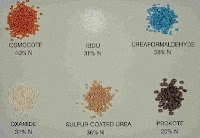 |
| Fertilizer spreader |
Selecting the Right Rate of fertilizer application is only one of the 4R’s that must be considered when making nutrient decisions. In addition to selecting the Right Rate, it is also essential to choose the Right Source, the Right Time, and the Right Place to get the maximum value. When one of these 4R’s is changed, it is necessary to evaluate how it impacts the remaining 4R factors.
Here are a few examples of how only modifying the fertilizer application rate may not achieve the desired results:
• It is important that growing crops have the right combination of all nutrients present in the rootzone, especially during periods of peak demand. If the nutrient supply during these critical times is not adequate to support growth then crop yields and quality will suffer.
• Nutrient applications should be made as close to the time of plant uptake as feasible. Some nutrients can be placed in the soil in advance of plant uptake because of their limited mobility; however other nutrients are at risk of loss if they remain in the soil for an extended period of time.
• When organic materials are used as a plant nutrient source, a period of mineralization is required before the nutrients are converted to a form that can be taken up by roots. Sufficient time is required for mineralization to synchronize nutrient release with plant uptake.
 |
| Elephant manure spreader? |
• There are numerous examples to show that when plants are not supplied with a balanced and appropriate supply of all the essential nutrients, none of them will be fully used to their potential. For example if a soil is low in K, then nitrate will not be properly taken up and may be more prone to leaching loss.
• Some fertilizer sources are more suitable for placement close to the seed than other sources, which may cause damage to germinating seedlings. Placing fertilizer close to the seed can provide some early-season growth stimulation in some circumstances.
 |
| Examples of controlled-release fertilizer |
• Controlled-release technology can reduce the risk of nutrient loss and eliminate the need for multiple trips through the field to apply fertilizer. Enhanced nutrient recovery by plants is often reported when these nutrient sources are used.
• Custom blends of fluid fertilizers allow a precise combination of nutrients to be delivered to the soil in each drop. Each droplet provides uniform and consistent nutrition to the plant. Some compound fertilizers and additives are formulated to control the soil environment around the granule to enhance plant nutrient recovery.
 |
| Fertilizer is essential to sustaining food production |
These few examples illustrate how an overly narrow focus on fertilizer application rate alone can cause growers to miss their overall objective—that is growing a high yielding and high quality crop that is both economically profitable and environmentally sound. When the 4R Nutrient Stewardship approach is implemented on each field, it is clear that no one of them can dominate nor be excluded. It is NOT all about the fertilizer application rate, because the source, time, and place decisions must all be considered to get the rate right.
A pdf version of this IPNI newsletter can be found at: HERE
No comments:
Post a Comment